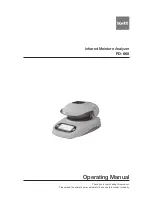
15
6. Measurement Procedure
If a measurement is performed immediately after turning on the power, an error may be caused. It is recommended
to leave the instrument for approx. 30 minutes after turning on the power or perform "Pre Heat" (see "■ Tips on
how to ensure accurate measurements, ● First measurement" on page 18).
Before beginning a measurement, check to make sure that the sample dish is appropriately placed and there is no
residue remaining in the sample dish. Proceed to the measurement procedure after ensuring that every part of the
main unit is stable and that the heater lid is firmly closed in particular (see "5. Assembly and Installation" on page 12).
①
Settings
When performing measurements for the first time,
or when you wish to change current settings before
measuring, then you should specify the measurement
settings.
(see "7. Specifying Measuring Settings" on page 20)
②
Zero Point Adjustment
Check to make sure that the stability indicator (O) is being
displayed, and then press the [
Tare/Reset
] key.
“-----” is displayed on the screen. The sample dish and
wind shield move vertically and the zero adjustment is
performed.
The procedure is completed after the [
Tare/Reset
] key
lights with a beep and “0.000g” is displayed.
* Always confirm that the heater lid is closed when
performing a tare. Also make sure that the tester is not
exposed to drafts or wind, or subjected to any vibrations
when a tare is being performed.
③
Placing a sample on the sampling tray
Open the lid to the heater and place the sample inside.
Be sure to place the sample as flat as possible into the
tester so that heat is evenly applied to the sample during
measurement.
(See “■ Tips on how to ensure accurate measurements”
on page 18 for further information.)
○
×
During zero adjustment (taring)
Beep






























